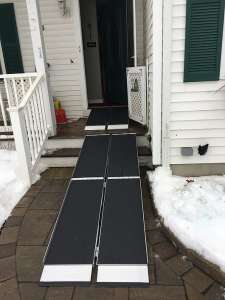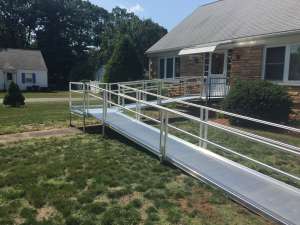Types of Wheelchair Ramps for Homes
If you’re wondering what types of wheelchair ramps for homes are available, this article will answer your questions. We’ll explore various ramp options, from portable to permanent, to help you find the right solution for your home.
Key Takeaways
- Threshold, folding, suitcase, telescoping, modular, permanent, rollable, and switchback ramps each serve unique accessibility needs and environments.
- Key factors for selecting a wheelchair ramp include weight capacity, material safety features, installation requirements, and compliance with ADA guidelines.
- Understanding the different ramp types ensures informed choices that enhance home accessibility, independence, and safety for wheelchair users.
Threshold Ramps
Threshold ramps help wheelchair users cross doorways and navigate small barriers, making them an essential addition to any accessible home. These ramps eliminate entry barriers like steps or raised doorways, providing smooth transitions between spaces. Threshold ramps offer a simple yet effective solution for front doors, sliding patio doors, or even interior doorways.
Threshold ramps, made from rubber or metal, cater to various needs and preferences. Rubber threshold ramps, often produced from recycled materials, are durable and budget-friendly. Aluminum threshold ramps, on the other hand, feature non-slip surfaces, enhancing safety, especially in wet conditions. These materials ensure that threshold ramps are resilient and safe for everyday use.
One of the standout features of threshold ramps is their adaptability. They accommodate heights from 1/2 inch to 6 inches, making them suitable for various barriers. Many threshold ramps support up to 300 pounds, handling the demands of daily use. Their cost-effectiveness and ease of installation make them a convenient solution for improving home accessibility.
Folding Ramps
Folding ramps offer a versatile, portable solution for temporary or occasional access. They come in two main designs: bi-fold and tri-fold. Bi-fold ramps fold once, while tri-fold ramps fold three times, making them compact and easy to store. Constructed from lightweight aluminum, these ramps are not only durable but also easy to transport, making them ideal for on-the-go use. A folding ramp can enhance accessibility in various settings.
While folding ramps are very practical for personal use, they are not ADA-compliant and are not recommended for commercial settings. Therefore, they are best suited for home environments where users need a quick, temporary ramp solution.
Despite their limitations, folding ramps balance portability and functionality, especially for frequent movers.
Suitcase Ramps

Suitcase ramps are designed to cross small sets of stairs, offering a robust and portable solution for residential use. They can support substantial weight, with a typical capacity of up to 800 pounds, making them suitable for various users. They can handle the demands of power wheelchairs and heavy-duty use, including a suitcase ramp.
Despite their utility, suitcase ramps are not ADA-compliant and lack certain safety features required for public spaces. Thus, they are unsuitable for commercial settings but perfect for consistent home accessibility needs.
A key feature of suitcase ramps is their portability. They can be divided into two parts, making them easy to carry and store. Typically, these ramps are about four feet in length, providing sufficient reach to navigate small staircases while remaining compact. This portability combined with their robust design makes suitcase ramps an excellent choice for those needing a reliable yet movable ramp solution.
Telescoping Ramps
Telescoping ramps feature two narrow, extendable channels adjustable to different lengths. This design is useful for accessing vehicles and overcoming uneven surfaces, offering a flexible telescoping ramp solution.
However, telescoping ramps are not suitable for mobile scooters, as the wheels often do not align properly with the narrow channels. Despite this limitation, they remain an excellent choice for wheelchair users who need a ramp that can be easily stored and adjusted for various heights and distances.
Modular Ramps

Modular ramps are highly customizable and flexible, making them popular among homeowners. Typically made from durable materials like aluminum, these ramps are designed to withstand various weather conditions and require minimal maintenance. Colorbond steel is also recommended for its resilience and low upkeep.
One of the standout features of modular ramps is their ease of installation. They can be assembled quickly without complex construction methods. Modular ramp sections are built off-site and transported for rapid assembly at the installation location, often taking just a few hours to set up. This makes them convenient for those needing a robust ramp without lengthy construction.
In terms of capacity, modular aluminum ramps can support up to 1,000 pounds, making them suitable for a wide range of users. Their cost varies from $1,000 to over $10,000, depending on material and installation complexity. This flexibility in price and design allows for tailored solutions that meet specific needs and budgets.
Another benefit is their potential for removal and resale. Since they do not cause damage to the property during installation, they can be removed and even resold if no longer needed. This adds an element of future-proofing and financial recoupment, making modular ramps a smart investment.
Permanent Ramps

Permanent ramps, made from concrete or wood, offer long-term home accessibility solutions. They are sturdy and reliable options for permanent fixtures. However, wooden ramps require proper planning to ensure structural integrity and long-lasting performance.
Installing permanent ramps requires more effort than modular ramps. They require building permits and must adhere to specific regulations, making the process more time-consuming and complex. Once installed, these ramps cannot be moved, which is an important consideration for homeowners.
Despite the challenges, permanent ramps withstand harsh conditions and offer a durable home accessibility solution. However, once built, they can be difficult and expensive to remove or modify, so careful planning and consideration are essential.
Rollable Ramps
Rollable ramps are a convenient and portable solution for temporary accessibility needs. Typically made from aluminum, they are lightweight and easy to transport. Their non-slip surface ensures a secure grip even in wet conditions.
The portability of rollable ramps makes them an excellent choice for individuals who need a portable ramp that can be easily carried and set up wherever needed. Their lightweight design makes them practical for those on the move.
Switchback Ramps
Switchback ramps feature a zigzag pattern, ideal for navigating limited spaces. They alternate directions with 180-degree turns, fitting into tight areas while still providing a smooth transition from one level to another.
Switchback ramps, made from aluminum and steel, often include resting platforms between slopes for added safety and comfort. They offer durability and aesthetic flexibility.
Due to their permanent nature, they typically require a building permit, adding another consideration to their installation.
Choosing the Right Material for Your Wheelchair Ramp
Selecting the appropriate material for your wheelchair ramp is crucial for ensuring safety, durability, and aesthetic appeal. The most common materials used for wheelchair ramps include aluminum, wood, and concrete. Each material offers unique benefits and considerations that can influence your decision.
Aluminum Ramps
Aluminum ramps are a popular choice due to their lightweight nature and resistance to rust and corrosion. They are ideal for temporary and permanent installations and are often used in modular ramp systems. Aluminum ramps are easy to maintain and offer non-slip surfaces for added safety. Their sleek appearance can complement modern home designs, making them a versatile option for many homeowners.
Wood Ramps
Wood ramps provide a natural and aesthetically pleasing option that can blend seamlessly with home exteriors. They are typically more cost-effective than other materials, making them an attractive choice for budget-conscious homeowners. However, wood ramps require regular maintenance to protect against weather damage and ensure longevity. Proper sealing and treatment are essential to prevent rot and maintain structural integrity.
Concrete Ramps
Concrete ramps are the most durable solution, suitable for permanent installations. They can withstand heavy loads and harsh weather conditions, providing a long-lasting accessibility solution. While concrete ramps require more time and effort to install, their stability and strength make them a worthwhile investment for those seeking a permanent fixture. Additionally, concrete ramps can be customized with various finishes to enhance their appearance and match the home’s style.
By carefully considering each material’s advantages and limitations, you can choose the right wheelchair ramp to meet your mobility needs, budget, and aesthetic preferences. Whether you prioritize durability, cost-effectiveness, or ease of maintenance, selecting the appropriate material is a key step in enhancing home accessibility.
Factors to Consider When Choosing a Wheelchair Ramp
Selecting a wheelchair ramp involves considering several factors to meet specific needs. Different ramp types, such as modular, threshold, and portable, cater to various requirements. Additionally, the length of the ramp should be based on the height it needs to accommodate, following the ADA guideline of one foot of ramp for every inch of rise.
Weight capacity is also important. Bariatric threshold ramps can support up to 800 pounds and handle heavier loads.
Surface material is vital for safety, and ramps should have slip-resistant features to prevent accidents. Considering several factors helps choose a ramp that meets mobility needs and ensures safety and convenience.
The Importance of Knowing About Different Types of Wheelchair Ramps
Knowing the different types of wheelchair ramps is crucial for making informed decisions that cater to specific needs. Wheelchair ramps fall into two broad categories: portable and permanent. Each has its own advantages and limitations. This knowledge helps select the right ramp for the best home accessibility solution.
Installing a power wheelchair ramp enhances home comfort and accessibility, allowing wheelchair users to regain independence and safety. Being informed about various types of wheelchair ramps ensures specific mobility needs are met effectively, enhancing quality of life. Additionally, it is important to consider whether the home is wheelchair accessible.
Summary
Selecting the right wheelchair ramp is a pivotal decision to greatly enhance home accessibility and independence. From threshold ramps for small barriers to switchback ramps for tight spaces, each type offers unique benefits tailored to different needs. By understanding the various options available—such as folding ramps for portability, suitcase ramps for stairs, telescoping ramps for vehicles, modular ramps for flexibility, and permanent ramps for long-term solutions—homeowners can make informed choices that best suit their specific situations.
Ultimately, the right wheelchair ramp not only provides physical accessibility but also peace of mind and improved quality of life. At Oakley Home Access, our experienced contractors are committed to delivering exceptional craftsmanship and personalized solutions that enhance mobility and independence. Whether you choose a quick-to-install modular ramp or a durable permanent ramp, we ensure your home is accessible and safe. Contact us today to discover how our tailored services can meet your mobility needs and transform your home’s accessibility.
Frequently Asked Questions
What is a common barrier that wheelchair ramps can help eliminate?
A common barrier that wheelchair ramps can help eliminate is the entry obstacles created by steps or raised doorways, allowing for easier access to homes.
What percentage of seniors prefer to remain at home as they age?
Approximately 90% of seniors prefer to remain at home as they age, according to an AARP survey. This highlights the strong desire for independence among older adults.
What is the recommended rise to ADA ramp slope ratio?
The recommended rise to ADA ramp slope ratio is 1:12, which means that for every 1 inch of vertical rise, there should be 12 inches of ramp length. This ensures safe accessibility for individuals with disabilities.
What is the weight capacity of a modular aluminum wheelchair ramp?
The weight capacity of a modular aluminum wheelchair ramp is typically 1,000 lbs, ensuring safe and reliable use for most individuals.
How much can a wheelchair ramp typically cost?
A wheelchair ramp typically costs between $1,000 and over $10,000, influenced by the materials used and the installation’s complexity. It’s essential to consider these factors when budgeting for a ramp.
